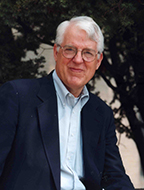Remembering Gerald Mahan
December 8, 2021
Gerald D. Mahan, one of the original UT-ORNL Distinguished Scientists, passed away November 22 at the age of 84, following a brief illness. He was the first UT faculty member to be elected to the National Academy of Sciences and leaves an impressive legacy as a scientist and a professor.

Gerald D. Mahan
(photo courtesy of PSU)
Mahan was a theorist who described his research in solid state physics and materials as part pure research and part applied technology. On the pure research side was the theory of many-electron systems and their response to external probes such as light. His work involved insulators, semiconductors, and metals, and considered photon frequencies from the infrared to the x-ray. He wrote several landmark papers on the theory of photoemission when the experimental developments were still in their infancy. He also investigated the theory of transport of current, heat, and light. On the applied side he was using an understanding of materials to engineer new ones by combining three or four elements, or by envisioning artificially structured materials such as thin film superlattices. Mahan worked with industries to understand the behavior of real devices, such as ZnO varistors (which suppress electrical surges) or thermoelectrics (solid state refrigerators), and tried to improve their performance using new materials.
Mahan earned an AB in physics from Harvard in 1959 and a PhD in theoretical physics from the University of California, Berkeley, in 1964. He was a research physicist at General Electric Corporate Research and Development Center for three years before joining the faculty at the University of Oregon in 1967. From there he went to Indiana University, where he directed the Materials Research Laboratory, staying a decade before coming to Knoxville as part of a new initiative between UT and Oak Ridge National Laboratory.
In 1984 Mahan was one of the first two professors to be appointed a Distinguished Scientist in a new Center of Excellence, the Science Alliance. The Distinguished Scientist program recruited internationally prominent scientists to jointly-appointed faculty positions at the university and research positions at ORNL. Mahan’s respective homes were UT Physics and Astronomy and the ORNL Solid State Division. During his tenure here he was the first UT faculty member elected to the National Academy of Sciences (1995). He left the university in 2001 to become a Distinguished Professor at the Pennsylvania State University and was a Distinguished Emeritus Professor there when he died.
Mahan was also a prolific author, not only of scientific papers but also of textbooks, including Many Particle Physics, Condensed Matter in a Nutshell, and Quantum Mechanics in a Nutshell. His scientific contributions won numerous accolades, including: Outstanding Achievement in Thermoelectrics Award from the International Thermoelectric Society (2015); Erasmus Mundas Lecturer of the European Union (2011); Foreign Member, Royal Society of Arts and Sciences, Göteborg, Sweden (2008); Eberly College of Science Medal (2007); and election to the American Academy of Arts and Sciences (2005).
Professor Mahan leaves behind his beloved wife of 56 years, Sally Mahan, and his children Christopher, Susan, and Roy. A symposium in his honor is tentatively scheduled for the spring.